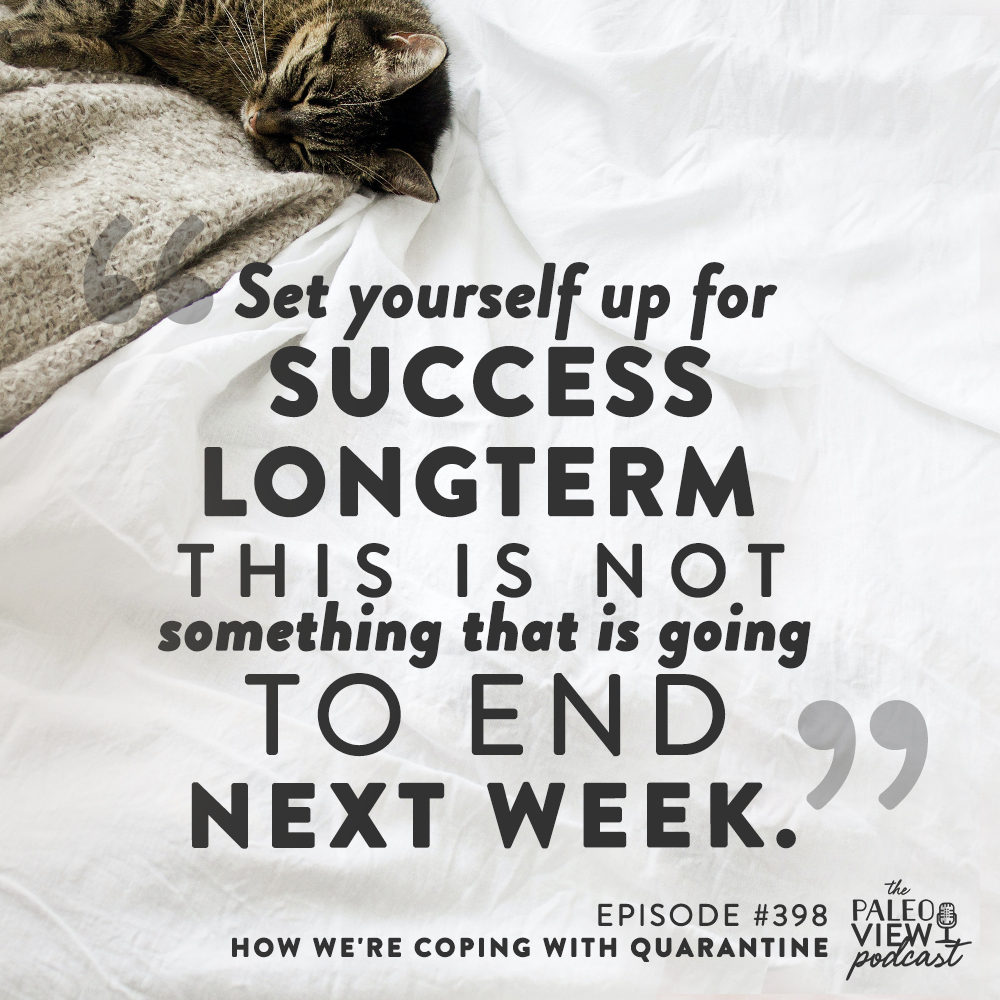
On this week’s episode, Stacy and Sarah share tips on how to cope with quarantine and the new challenges that we are all facing during this pandemic. The hosts cover strategies for working from home, overseeing distance learning, prioritizing self-care, shopping and much more. Tune in below!
If you enjoy the show, please review it on iTunes!
The Paleo View (TPV), Episode 398: How We’re Coping with Quarantine
Welcome back to the Paleo View, 398. (0:40)
For those of you who are listening in the future, we are still very much immersed in covid-19 at the time of the episode’s recording.
Specifically, in the United States, the number of diagnosed cases has surpassed other countries and continues to rise.
For this week’s episode, Stacy and Sarah wanted to share solutions to help us all cope with the quarantine.
Stacy’s resolution for the year is to be solution-oriented and to be a problem solver, which has worked out this year.
We are all in unprecedented times, and we are all working through various stages of emotions from one day to the next.
Fluctuations in these emotions are very normal.
This period can cause trauma and will evoke stages of grief.
We are all grieving a lot of different things right now, which brings about a range of emotions.
All of this is normal.
Stacy and Sarah want to help listeners identify the things you can focus your attention and energy on in positive ways.
We want to help listeners positively and proactively funnel your energy so that if you are in a state of overwhelm you can do some things that help you.
Stacy personally put some of the examples that they are going to share on today’s episode into practice last week and she greatly benefited from them.
All of the information that they are going to share is science-backed and has to do with emotional health.
Personal Experiences
One of the things that Sarah has been doing in her home is a chronic adaptation. (4:00)
They have had to do a lot of problem-solving to figure out how to adapt to challenges during this time.
Sarah is finding that this situation is challenging her adaptability.
It is such a dynamic situation, and so much is out of our control.
To recognize what to control in your immediate environment can be a difficult thing to assess.
What has been most beneficial for Sarah’s family is to fully adhere to social distancing and physical isolation guidelines.
There are new studies looking at asymptomatic transmission and that you can still spread the virus when you are an asymptomatic host. (see here and here)
More data needs to be collected on this, but until it is available, we have to respect the guidelines that are being given.
We have to protect the vulnerable members of our community and it could be a long haul.
Sarah is asking the question, “how can I make this time something healthy for my family?”.
How can we continue our priorities with a healthy diet and lifestyle? How can we support our mental health?
And how can we still have social connections and make this physical isolation sustainable?
We are all trying to figure this out.
None of us have had to do this before, and figuring out how to do it is a big challenge.
Stacy too loves the importance of distancing ourselves from the words “social distancing”, but to instead think of it as physical distancing.
While we are isolated, many of us are not actually alone.
For those of you who are alone, Stacy’s heart is with you.
Make sure you are getting enough time for you.
Stacy realized she wasn’t getting alone time and had to make that shift.
Working From Home
While Stacy and Sarah are use to working from home, the challenge is that the house is now full of people. (14:10)
Sarah and Stacy are missing their time alone, and the ability to think about their selfish needs.
It impacts efficiency when you are working from home and accomodating those around you, especially students who need guidance with distance learning.
Sarah has had to set up separate workstations for everyone in the family.
They had to assess their needs and work around that when determining what each station needed.
Stacy shared a glimpse into what her workdays look like.
Set reasonable expectations for what you can accomplish each day.
Stacy also shares her schedule with her boys and lets them know what she needs them to accomplish within the time frame that she is working.
This is really helping with her effectiveness.
Remember to feel good about the things you are accomplishing!
Sarah has changed her daily routine quite a bit, and she shared more about her new schedule.
They are still living following a routine.
Bedtime is still a priority, but Sarah and her husband are no longer setting an alarm clock.
Sarah is enjoying the chance to start the day working in her pajamas.
She has been working a 7 to 3 schedule but is incorporating breaks for family time.
Exercise time has been built into a time window when her focus typically changes.
This has helped Sarah’s productivity.
Since Sarah’s stress levels are overall higher, she is being very acutely aware of when she needs to pivot into stress-reducing activities.
Sarah has been proactive to adapt to the day-to-day changes, emotions, stress levels, etc.
Stacy shared on the importance of thinking through how your children are feeling during this time and giving them time to express those emotions.
Feelings of chaos can trickle to those around you.
Family meetings can be a great tool to help create a platform for sharing, managing expectations, and listening to others.
In Stacy’s household, they have had to recently be very mindful of their screentime usage.
For Matt and Stacy, they position it so that the kids earn their screentime by doing various tasks.
It became a positive mindset shift when the boys looked at it from the point of earning it, as opposed to screentime being taken away or reduced.
Distance Learning
Matt and Stacy’s boys haven’t yet been given the tools for distance learning. (36:20)
They will soon be rolling out optional online classes starting in mid-April.
However, Stacy doesn’t exactly know what that means and she isn’t going to worry about it until they need to.
Sarah noted that one of the challenges that we are having as a country is that every area is doing things differently.
The shutdown is magnifying inequities that were already there.
Sarah shared about how frustrating it is to not know what to expect because things keeping changing so frequently.
They are still trying to figure out with Sarah’s kids how they will determine where the students will land within the curriculum by the end of the academic year.
For Sarah, her daughters have loved learning from home.
They too have been utilizing family meetings to identify what the kids need.
Sarah feels so much gratitude for her kid’s teachers and their school, and the innovative things they are doing.
Regardless of where your school district is at in unrolling distance learning, finding a way to maintain structure and routine for kids is key.
When they need breaks, let them take breaks.
The kids will help guide what they need.
Sarah shared more about how her daughters have been guiding and structuring their routines.
Arts and crafts projects have also been a great use of time for them, especially as a way to connect with family and friends they can’t see.
They have also been going through their board game closet as well.
Sarah and her husband have been working hard to maintain as much normalcy as possible, and take the things that are abnormal and use the time for family bonding.
They will continue to troubleshoot and adapt as time goes on and as time presents new challenges.
If you are not doing enrichment activities it is ok.
Take the time and space you need to decompress and spend that time with your family.
It will take time to find your new normal.
For Stacy, they have been selecting activities for boys that they can do from start to finish.
Also giving them tasks that they can own has been key.
Some more ideas from Stacy: yard work, cleaning out closets, donating old clothes and toys, pulling items from your pantry for the food bank, and reorganizing bookshelves.
Give the kids (and yourself) wins, whatever that may look like.
Set yourself for as many wins as possible.
Shopping
Sarah wants to acknowledge the challenge of shopping for groceries and other essentials. (51:43)
Stacy and Sarah are both tackling this differently, and they want to share some ideas and suggestions on this unique challenge.
This has been one of Sarah’s biggest changes to her routine.
Sarah use to shop three to four times a week and is now picking one store and going only there.
If they don’t have something that was on their life they live without it.
It has been challenging in terms of the meal planning aspect of it.
Sarah has been shopping for 10-days at a time.
It has been a mindset shift to be more flexible with meal planning and grocery shopping.
Sarah had her first grocery shopping trip recently and she wasn’t prepared for how anxiety triggering the experience would be.
Part of it was the planning aspect, and the other part was how to social distance, not touch her face, utilizing self-checkout.
She also expressed her appreciation for the employees showing up to do their job.
Stacy added that one of the things we can do to express our gratitude for these essential employees is to reach out to our local stores and share your positive feedback with managers.
It is also important to advocate that these employees should receive special pay for the work they are doing to help us live comfortably.
The more we can advocate for them the more helpful it will be.
Expressing gratitude to people as you encounter them while practicing social distancing, is really important.
Stacy shared on the letter that Matt received for thanking him for his work and how special it was to receive that gesture of gratitude.
A look into Stacy’s grocery shopping experience: she went once and will not be going back again.
Stacy did look into what the CDC says about where the virus can live and for how long.
It can live on soft things, but it is very low risk.
Stacy shared more about how they have been handling shipments.
Check out this resource for more information.
Sarah has been viewing things as potentially contaminated, but not necessarily requiring disinfection.
Slow shipping has been an option that Sarah has been taking advantage of for a number of reasons.
Sarah shared more on how she has handled shipments.
Each of us needs to evaluate our individual risk.
All of the recommendations that Stacy and Sarah are sharing are based on CDC and FDA resources.
Stacy has restarted her Hungry Harvest subscription, and then uses that order to meal plan off of.
She is also ordering from Butcher Box again.
They are also ordering from Thrive Market now as well.
Use this link and get $20 off, with no membership fees for 30-days.
Stacy is ordering ahead knowing that there are shipping delays right now.
Another route that Stacy is using is ordering from local stores that offer curbside pickup and/or delivery.
It is an individual choice as to which approach is going to work best for you and your mental state.
There are different ways to approach it that are going to make sense to you.
Mental Health
One of the things that both Stacy and Sarah have experienced with this pandemic is new mental health challenges. (1:15:30)
Give yourself the grace to feel your feelings and be ok with the ways your feelings change.
Stacy has been trying to enjoy things that they don’t get to do very often.
Finn loves to bake and Stacy has been making the time to bake with him, giving him different challenges during the process.
Stacy has also been spending more time in the hot tub.
Other self-care ideas include painting your nails, taking baths, and finding pockets of things that allow you to enjoy the process.
One of the things that Sarah has been doing is calling friends and family.
Reaching out to strengthen one-on-one connections has been very helpful to Sarah’s mental health.
Brushing up an old skill and an old hobby with her little brother has been very moving.
Sarah has been focused on giving herself things to do that require her whole brain.
She shared more on some of her current writing projects and how she is focused on incorporating hobbies as well.
Finding a group to collaborate with can be very beneficial.
Doing things together makes you feel a little less alone.
Closing Thoughts
Finding ways to not overwhelm yourself is critical during this time. (1:24:34)
Set yourself up for success longterm – this is not something that is going to end next week.
Do things that you can sustain, and not get yourself overwhelmed.
Ask for help as well.
Stacy shared information on how she is going to set boundaries and expectations around distance learning when the time comes.
Turn to a support circle when you need to vent and process emotions.
People want to hear that they are not alone in their feelings.
Be careful about being in a negative mindset.
A productive vent session can be a great goal to strive for.
There are things we can’t change, but taking everything one day at a time makes it more palatable.
We are all in this together.
This is a global, community-wide effort to protect the vulnerable and our healthcare workers.
We are going to get through this and will one day tell our grandchildren about this experience.
Take a step back and look at the challenge to find a creative solution that will work for your life.
This is what we are all challenged with this normal that requires adaptation, self-sacrifice, but it is all something we are doing together for the greater good.
Thank you for tuning in, and for however you are contributing to society right now.
Stacy and Sarah will be back again next week! (1:30:39)





